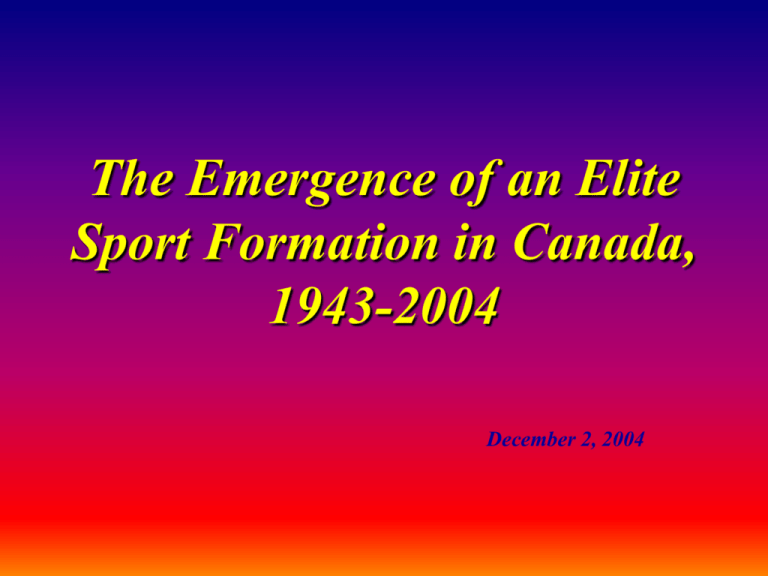263F Presentation
advertisement

The Emergence of an Elite Sport Formation in Canada, 1943-2004 December 2, 2004 To understand sport policy & shifts in priority we must place development in the wider political & social changes that have occurred in Canada World Expositions (1851) To understand sport policy & shifts in priority we must place development in the wider political & social changes that have occurred in Canada Olympic Games (1896) World Expositions (1851) To understand sport policy & shifts in priority we must place development in the wider political & social changes that have occurred in Canada Olympic Games (1896) The Duke of Edinburgh (1959) World Expositions (1851) To understand sport policy & shifts in priority we must place development in the wider political & social changes that have occurred in Canada Olympic Games (1896) The Duke of Edinburgh (1959) Expo ‘67 World Expositions (1851) To understand sport policy & shifts in priority we must place development in the wider political & social changes that have occurred in Canada Olympic Games (1896) The Duke of Edinburgh (1959) Federal Election (1968) Expo ‘67 World Expositions (1851) To understand sport policy & shifts in priority we must place development in the wider political & social changes that have occurred in Canada Olympic Games (1896) The Duke of Edinburgh (1959) Federal Election (1968) Expo ‘67 World Expositions (1851) Summit Series (1972) To understand sport policy & shifts in priority we must place development in the wider political & social changes that have occurred in Canada Olympic Games (1896) The Duke of Edinburgh (1959) Federal Election (1968) Expo ‘67 World Expositions (1851) Summit Series (1972) To understand sport policy & shifts in priority we must place development in the wider political & social changes that have occurred in Canada Montreal Olympics (1976) Olympic Games (1896) The Duke of Edinburgh (1959) Federal Election (1968) Expo ‘67 World Expositions (1851) Summit Series (1972) To understand sport policy & shifts in priority we must place development in the wider political & social changes that have occurred in Canada Montreal Olympics (1976) Calgary Olympics (1988) Olympic Games (1896) The Duke of Edinburgh (1959) Federal Election (1968) Expo ‘67 World Expositions (1851) Summit Series (1972) To understand sport policy & shifts in priority we must place development in the wider political & social changes that have occurred in Canada Montreal Olympics (1976) Ben Johnson/ Dubin Inquiry (1988-90) Calgary Olympics (1988) Olympic Games (1896) The Duke of Edinburgh (1959) Federal Election (1968) Expo ‘67 World Expositions (1851) Summit Series (1972) To understand sport policy & shifts in priority we must place development in the wider political & social changes that have occurred in Canada Montreal Olympics (1976) Salt Lake City Hockey (2002) Ben Johnson/ Dubin Inquiry (1988-90) Calgary Olympics (1988) Olympic Games (1896) The Duke of Edinburgh (1959) Federal Election (1968) Expo ‘67 World Expositions (1851) Summit Series (1972) To understand sport policy & shifts in priority we must place development in the wider political & social changes that have occurred in Canada Vancouver (2010) Salt Lake City Hockey (2002) Montreal Olympics (1976) Ben Johnson/ Dubin Inquiry (1988-90) Calgary Olympics (1988) http://www.cbc.ca/story/sports/national/2004/11/29/Sports/coc041129.html Olympic Games (1896) The Duke of Edinburgh (1959) Expo ‘67 Federal Election (1968) World Expositions (1851) Summit Series (1972) To understand sport policy & shifts in priority we must place development in the wider political & social changes that have occurred in Canada Vancouver (2010) Salt Lake City Hockey (2002) Montreal Olympics (1976) Ben Johnson/ Dubin Inquiry (1988-90) Calgary Olympics (1988) Factors Inhibiting Early Government Action in Sport: • Protestant values • Jurisdiction • Issues of autonomy Canadian Sport Policies for Analysis: 1943 - National Physical Fitness Act 1961 - The Fitness & Amateur Sport Act 1969-73 - Towards Sport Canada 1979 - Towards a New Sport Policy 1980 - Policies and Programs in the 1980s 1998 - The Mills Report 2002 - An Act to Promote Physical Activity & Sport -1943- National Physical Fitness Act • Considered a Wartime Act • In-line with objectives of the Canadian Welfare State in post-Depression years • Defined ‘fitness’ as “the best state of health…necessary for a life of service to one’s family & country…” • Primary emphasis was on mass participation -1943- con’t National Physical Fitness Act Retraction of the NPFA: • King government quietly pulled back from its ‘Green Book’ promises for postwar reconstruction • Act was officially repealed in 1954 -1961- Bill C-131 The Fitness and Amateur Sport Act • Enacted under Prime Minister Diefenbaker in 1961 • Officially committed the federal government “to encourage, promote, & develop fitness and amateur sport in Canada” • The National Advisory Council was established by the Act to oversee the implementation of the program -1961- Bill C-131 con’t The Fitness and Amateur Sport Act Key Events and Agents associated with the Act: 1) Administrative structure & personnel 2) Federal/provincial cost-sharing agreements 3) Grants to sport governing bodies 4) The Canada Games 5) Scholarships & research awards -1961- Bill C-131 con’t The Fitness and Amateur Sport Act Weaknesses of the Act: • Its broad scope meant that expectations were often distanced considerably from the reality of implementation • By 1968, conflicting government views between mass & elite sport were clear • Issues arose concerning cost-sharing programs • Questions of national unity & nationalism -1969-1973- Towards Sport Canada 1969 – Federal Government Task Force on Sport for Canadians • Reported on the governments scant involvement in sport (elite sport) Forces that Shaped Government Sport Directions in the 1970s: • The National Unity Crisis • Sport Transformation • Sport and National Unity -1969-1973- con’t Towards Sport Canada 1970 – A Proposed Sports Policy for Canadians (The White Paper) • Emanated from the Report of the Task Force on Sport for Canadians • Emphasis was on the improvement of Canadian performance in international competition & the development of elite athletes -1969-1973- con’t Sport Canada 1971 – Sport Canada and Recreation Canada • The Proposed Sports Policy for Canadians, the national unity crises, & Montreal’s successful bid for the 1976 Olympics helped to build momentum for increased federal involvement in sport • In 1971, Munro announced that two separate directorates were to be created: -1969-1973- con’t Sport Canada Sport Canada: Dedicated to elite sport & improve Canadian performances in international competitions Recreation Canada: Provided Canadians with opportunities to participate in physical recreation & to improve fitness levels con’t Sport Canada (1970s) • Sport Programs & Direct Government Output: – – – – – – – 1976 Montreal Olympics – ‘Game Plan’ National Sport and Recreation Centre Hockey Canada ParticipAction Coaching Association of Canada Canada & Arctic Winter Games First Minister of State for Fitness and Amateur Sport -1979- Towards a New Sport Policy • Canadian improvement in international amateur sport events (Montreal) • Federal failures in recreation • Growth in the amateur sport bureaucracy in Canada & bias to elite sport • Trudeau’s unifying vision supported -1977-1979- con’t Towards a New Sport Policy The Green Paper (1977) • A proposal paper • Highly controversial – dealt exclusively with sport • Criticisms justified with the separate Green Paper for Recreation The White Paper (1979) • Proposal for legislative change • Dealt exclusively with sport • Campagnolo justified this focus by acknowledging the provinces & municipalities as the appropriate administrators of recreation -1980s- Policies and Programs in the 1980s • • • • • • 1981 – Regan White Paper High-Performance Sport Centres Hosting Policy Athlete Assistance Program “Best Ever ’88” CAAWS -1998- The Mills Report • First Government initiative to examine the ‘industry of sport’ Mandate of the Sub-Committee: 1) Measurement of economic impact of sport on a national and regional basis 2) Contribution of sport to the cultural sphere – sport’s impact on national unity 3) Potential scope of, & rationale for, federal involvement in sport • Overall, the impact of sport and recreation sector on Gross Domestic Product was $8.9 billion -2002- Bill C-54 An Act to Promote Physical Activity & Sport -2002- Bill C-54 An Act to Promote Physical Activity & Sport • Replace and modernize the Fitness and Amateur Sport Act • Responds to the complexities of the modern world of sport • Supports the development of the Canadian sport system • The term “fitness” would be replaced with “physical activity” • The term “amateur” is removed from the Act -2002- Bill C-54 An Act to Promote Physical Activity & Sport Measures to pursue the objectives: • • • • • • Encourage the promotion of sport Under-represented groups Co-ordinate federal initiatives Encourage provincial & territorial governments Encourage the private sector Encourage an alternative dispute resolution Sport and the National • Privileged place of sport in the construction of national identity (press) • Inclusion and exclusion of populations • National images to support political & social agendas (Confederation) • Sport of hockey • Vancouver 2010 Sport and the National THE END





